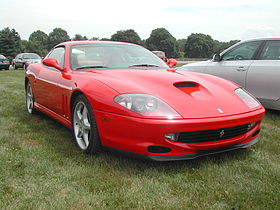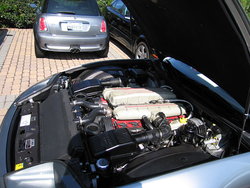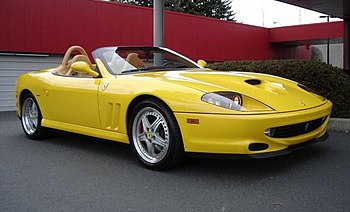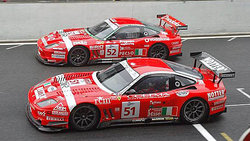Difference between revisions of "Ferrari 550"
m |
m |
||
| (5 intermediate revisions by the same user not shown) | |||
| Line 1: | Line 1: | ||
| − | + | {{X}} | |
| − | {| border=1 | + | {| border=1 cellspacing=3 cellpadding=4 style="float:right; margin:0 0 .5em 1em; width:250px; background:#505050; border-collapse:collapse; border:1px solid #999; font-size:83%; line-height:1.5; " summary="Infobox Automobile" |
| − | |- | + | |- style="text-align:center; background:#505050;" |
| − | |colspan=2|[[Image:Maranello.JPG| | + | | colspan=2 style="padding:0; background:#333333; color:#fff; border-bottom:1px solid #999;" |[[Image:Maranello.JPG|280px|2001 Ferrari 550 Maranello]] |
| − | |- | + | |- style="color:#fff; background:darkred; font-size:larger;" |
| − | + | ! colspan=2 |'''Ferrari 550<br>Maranello, Barchetta''' | |
|- | |- | ||
|Manufacturer:||[[Ferrari]] | |Manufacturer:||[[Ferrari]] | ||
| Line 20: | Line 20: | ||
|Engines:||5.5 L [[V12]] | |Engines:||5.5 L [[V12]] | ||
|- | |- | ||
| − | | | + | |Transmission || 6-speed [[manual transmission|manual]] |
| + | |- | ||
| + | |Wheelbase || 2499 mm (98.4 in) | ||
| + | |- | ||
| + | |Length || 4549 mm (179.1 in) | ||
| + | |- | ||
| + | |Width || 1935 mm (76.2 in) | ||
| + | |- | ||
| + | |Height || 1278 mm (50.3 in) | ||
| + | |- | ||
| + | |Weight || 3725 lb (1690 kg) | ||
| + | |- | ||
| + | | colspan=2 style="padding:0; background:#333333; color:#fff; border-bottom:1px solid #999;" |<videoflash>dZpB09jru1s|280|200</videoflash> | ||
|} | |} | ||
| − | The ''' | + | The '''Ferrari 550 Maranello''' and '''550 Barchetta''' were 2-seat [[Gran Turismo]] [[sports car]]s built by [[Ferrari]]. Introduced in 1996, the 550 was an upmarket [[FR layout|front-engined]] [[V12]] coupe of the kind not seen since the [[Ferrari Daytona|Daytona]]. It shared its platform and 5.5 L (5474 cc) engine with the 2+2 [[Ferrari 456|456]] (Engine Code: F133) but was positioned as the company's highest-end model. The car used a transaxle layout, with the 6-speed manual gearbox located at the back, in-line with the driven wheels. The model number refers to total engine displacement (5.5 litres) and the model name of [[Maranello]] refers to the town where the Ferrari headquarters are located. |
| + | |||
| + | The demise that same year of the [[Ferrari Testarossa#F512M|F512 M]] left the company with only the exotic [[Ferrari F50|F50]] and V8 [[Ferrari F355|F355]] as [[MR layout|mid-engined]] models. Although the 550 was a softer GT model, it did take the place of the F512 M as the company's upmarket coupe, discounting the F50 [[supercar]]. | ||
| + | |||
| + | The 550 featured a luxurious and roomy interior. The (rear) trunk was tall and wide, though not very deep, and could accept a full set of [[golf club]]s or standard overnight bags. It also had performance to look up at, with a top speed at 323 km/h (201 mph) and a 0-100 km/h acceleration time of just 4.5 seconds. | ||
| − | The | + | The 550 line was replaced by the ''Modificata'' [[Ferrari 575M Maranello|575 M Maranello]] in 2002. |
| − | + | It was surprising at the car's launch that Ferrari had abandoned the famous mid-engined layout in favour of a front-mounted power unit, but this was quickly forgotten as the 550 soon established itself as one of the most desirable supercars of its era. It has been praised by magazines and tester all over the world | |
| − | + | == Specifications == | |
| + | ===Engine=== | ||
| + | [[Image:Ferrari 550 Maranello engine.jpg|thumb|250px|right| Ferrari 550 Maranello V12 engine]] | ||
| − | ==Barchetta== | + | The 550 Maranello is a [[FR layout|front-engined]] car. The engine is a [[naturally aspirated]] [[V12]] with [[multi-valve|4 valves per cylinder]], and [[dual overhead cam]]s. It displaces 5474 cc (334 in³) and produces 361.7 kW (485 hp) at 7000 rpm and 568.1 N·m (419 ft·lbf) at 5000 rpm. |
| − | [[Image:550Bar.JPG|thumb|left| | + | |
| − | Ferrari introduced a [[convertible]] version of the 550 at the [[Paris Motor Show]] in | + | ===Chassis=== |
| − | + | The 550 Maranello has an aluminum alloy [[chassis]] and 6-speed [[manual transmission]]. The steering is [[rack and pinion]] with variable power assist. The vented [[disc brake]]s are 330 mm (13.0 in) for the front and 310 mm (12.2 in) for the rear. | |
| + | |||
| + | {| border=1 cellspacing=3 cellpadding=4 style="float:center; margin:0 0 .5em 1em; width:400px; background:#505050; border-collapse:collapse; border:1px solid #999; font-size:83%; line-height:1.5; " summary="Infobox Automobile" | ||
| + | |- style="text-align:center; background:#505050;" | ||
| + | |- tr BGCOLOR=darkred | ||
| + | !Gear!!1!!2!!3!!4!!5!!6!!Final Drive | ||
| + | |- | ||
| + | |'''Ratio'''||3.15:1||2.18:1||1.57:1||1.19:1||0.94:1||0.76:1||3.91:1 | ||
| + | |} | ||
| + | |||
| + | ===Performance=== | ||
| + | The 550 Maranello can accelerate to 60mi/h in 4.2 seconds and can reach 161 kilometres per hour (100 mph) in 10.5 seconds. The ¼ mile (0.4 km) time is 13.1 seconds and the top speed is 320.3 kilometers per hour (199.0 mph). | ||
| + | |||
| + | ==550 Barchetta== | ||
| + | [[Image:550Bar.JPG|thumb|left|350px|2001 Ferrari 550 Barchetta]] | ||
| + | Ferrari introduced a [[convertible]] version of the 550 at the [[Paris Motor Show]] in 2000. This '''Barchetta''' was a true [[roadster]] with no real convertible top provided. The factory did provide a soft top, but it was intended only for temporary use as it was cautioned against using the top above 70mi/h. A total of 448 Barchettas were produced, four more than initially planned due to concerns of superstition in the Japanese market. The 448 cars were preceded by 10 prototypes numbered P01-P10 on their interior plaques. To an observer the prototypes and production cars are indistinguishable. | ||
| + | |||
| + | ==Motorsport== | ||
| + | Although not intended for motorsport, some privateer teams took it upon themselves to develop the 550 for use in various series. The first racing 550 was built for Red Racing to comply with [[FIA]] sporting regulations. Italtecnica aided in the development of the project. The car was termed a '''550 GT''' and was first tested in April 1999. It was used in the [[FFSA GT Championship]] in France from the end of 1999 until the end of 2000. The car was then sold to XL Racing in 2001 who continued to develop the car. The 550 GT made one of it's final appearances at the [[2003 24 Hours of Le Mans]]. In 2000, Italtecnica would create another 550 race car meeting the more powerful GT regulations in the [[FIA GT Championship]], but the car was short lived. | ||
| + | [[Image:05Spa 5152BMS550s.jpg|thumb|right|250px|A pair of BMS [[Scuderia Italia]] 550-GTS Maranellos at the [[2005 1000km of Spa]].]] | ||
| + | |||
| + | In 2001, [[Prodrive]] built racing customer versions of the 550 for various sports car series and especially the [[24 Hours of Le Mans]]. However, although this brought the Ferrari name into the sport, the cars would be built entirely by Prodrive without any support from the Ferrari factory. Named the '''550-GTS''', a total of ten cars would be built over the next four years and campaigned by the Prodrive team as well as privateer customers. | ||
| + | |||
| + | The factory Prodrive team would win two [[FIA GT Championship]] races in the cars debut in late 2001. The BMS [[Scuderia Italia]] team would take over in FIA GT, recording four wins, while the Prodrive squad would take a single win the [[American Le Mans Series]]. 2003 would be the best year for the cars, as Prodrive won the GTS class at the [[2003 24 Hours of Le Mans|24 Hours of Le Mans]], took second in the GTS class championship in the American Le Mans Series with four wins, and Scuderia Italia won the FIA GT championship with eight wins. | ||
| + | |||
| + | BMS Scuderia Italia would again take the FIA GT Championship with five wins in 2004, while [[Larbre Compétition]] would take the GT1 class championship in the new [[Le Mans Series]]. BMS Scuderia Italia would then move to the Le Mans Series as well and take that championship for 2005. At the same time, [[Prodrive]] would move to their next project, the [[Aston Martin DBR9]]. All 550-GTSs would be maintained by Care Racing, and a few continue to be used today. Convers MenX used a 550-GTS in the [[2007 24 Hours of Le Mans]], while Hitotsuyama Racing runs one in the full [[Japan Le Mans Challenge]] season. | ||
| + | |||
| + | Following the success of the 550-GTS, Ferrari would adapt the [[Ferrari 575M Maranello|575M]] for racing and offer it as a customer car for privateers. Some road legal Ferrari 550s would also be modified by small teams for racing, although these differed from the Prodrive-built 550-GTSs. | ||
==Awards== | ==Awards== | ||
The 5.5 L V12 engine won the "over 4 liter" class of the [[International Engine of the Year]] award for 2000 and 2001. | The 5.5 L V12 engine won the "over 4 liter" class of the [[International Engine of the Year]] award for 2000 and 2001. | ||
| − | |||
| − | |||
{{Ferrari vehicles}} | {{Ferrari vehicles}} | ||
[[Category:Ferrari vehicles|550 Maranello]][[Category:Sports cars]] | [[Category:Ferrari vehicles|550 Maranello]][[Category:Sports cars]] | ||
Latest revision as of 06:22, 14 October 2009

| |
| Ferrari 550 Maranello, Barchetta | |
|---|---|
| Manufacturer: | Ferrari |
| Class: | front-engined coupe |
| Production: | 1996 — 2001 |
| Predecessor: | Ferrari F512M |
| Successor: | Ferrari 575M Maranello |
| Body styles: | Coupe Barchetta |
| Engines: | 5.5 L V12 |
| Transmission | 6-speed manual |
| Wheelbase | 2499 mm (98.4 in) |
| Length | 4549 mm (179.1 in) |
| Width | 1935 mm (76.2 in) |
| Height | 1278 mm (50.3 in) |
| Weight | 3725 lb (1690 kg) |
The Ferrari 550 Maranello and 550 Barchetta were 2-seat Gran Turismo sports cars built by Ferrari. Introduced in 1996, the 550 was an upmarket front-engined V12 coupe of the kind not seen since the Daytona. It shared its platform and 5.5 L (5474 cc) engine with the 2+2 456 (Engine Code: F133) but was positioned as the company's highest-end model. The car used a transaxle layout, with the 6-speed manual gearbox located at the back, in-line with the driven wheels. The model number refers to total engine displacement (5.5 litres) and the model name of Maranello refers to the town where the Ferrari headquarters are located.
The demise that same year of the F512 M left the company with only the exotic F50 and V8 F355 as mid-engined models. Although the 550 was a softer GT model, it did take the place of the F512 M as the company's upmarket coupe, discounting the F50 supercar.
The 550 featured a luxurious and roomy interior. The (rear) trunk was tall and wide, though not very deep, and could accept a full set of golf clubs or standard overnight bags. It also had performance to look up at, with a top speed at 323 km/h (201 mph) and a 0-100 km/h acceleration time of just 4.5 seconds.
The 550 line was replaced by the Modificata 575 M Maranello in 2002.
It was surprising at the car's launch that Ferrari had abandoned the famous mid-engined layout in favour of a front-mounted power unit, but this was quickly forgotten as the 550 soon established itself as one of the most desirable supercars of its era. It has been praised by magazines and tester all over the world
Specifications
Engine
The 550 Maranello is a front-engined car. The engine is a naturally aspirated V12 with 4 valves per cylinder, and dual overhead cams. It displaces 5474 cc (334 in³) and produces 361.7 kW (485 hp) at 7000 rpm and 568.1 N·m (419 ft·lbf) at 5000 rpm.
Chassis
The 550 Maranello has an aluminum alloy chassis and 6-speed manual transmission. The steering is rack and pinion with variable power assist. The vented disc brakes are 330 mm (13.0 in) for the front and 310 mm (12.2 in) for the rear.
| Gear | 1 | 2 | 3 | 4 | 5 | 6 | Final Drive |
|---|---|---|---|---|---|---|---|
| Ratio | 3.15:1 | 2.18:1 | 1.57:1 | 1.19:1 | 0.94:1 | 0.76:1 | 3.91:1 |
Performance
The 550 Maranello can accelerate to 60mi/h in 4.2 seconds and can reach 161 kilometres per hour (100 mph) in 10.5 seconds. The ¼ mile (0.4 km) time is 13.1 seconds and the top speed is 320.3 kilometers per hour (199.0 mph).
550 Barchetta
Ferrari introduced a convertible version of the 550 at the Paris Motor Show in 2000. This Barchetta was a true roadster with no real convertible top provided. The factory did provide a soft top, but it was intended only for temporary use as it was cautioned against using the top above 70mi/h. A total of 448 Barchettas were produced, four more than initially planned due to concerns of superstition in the Japanese market. The 448 cars were preceded by 10 prototypes numbered P01-P10 on their interior plaques. To an observer the prototypes and production cars are indistinguishable.
Motorsport
Although not intended for motorsport, some privateer teams took it upon themselves to develop the 550 for use in various series. The first racing 550 was built for Red Racing to comply with FIA sporting regulations. Italtecnica aided in the development of the project. The car was termed a 550 GT and was first tested in April 1999. It was used in the FFSA GT Championship in France from the end of 1999 until the end of 2000. The car was then sold to XL Racing in 2001 who continued to develop the car. The 550 GT made one of it's final appearances at the 2003 24 Hours of Le Mans. In 2000, Italtecnica would create another 550 race car meeting the more powerful GT regulations in the FIA GT Championship, but the car was short lived.
In 2001, Prodrive built racing customer versions of the 550 for various sports car series and especially the 24 Hours of Le Mans. However, although this brought the Ferrari name into the sport, the cars would be built entirely by Prodrive without any support from the Ferrari factory. Named the 550-GTS, a total of ten cars would be built over the next four years and campaigned by the Prodrive team as well as privateer customers.
The factory Prodrive team would win two FIA GT Championship races in the cars debut in late 2001. The BMS Scuderia Italia team would take over in FIA GT, recording four wins, while the Prodrive squad would take a single win the American Le Mans Series. 2003 would be the best year for the cars, as Prodrive won the GTS class at the 24 Hours of Le Mans, took second in the GTS class championship in the American Le Mans Series with four wins, and Scuderia Italia won the FIA GT championship with eight wins.
BMS Scuderia Italia would again take the FIA GT Championship with five wins in 2004, while Larbre Compétition would take the GT1 class championship in the new Le Mans Series. BMS Scuderia Italia would then move to the Le Mans Series as well and take that championship for 2005. At the same time, Prodrive would move to their next project, the Aston Martin DBR9. All 550-GTSs would be maintained by Care Racing, and a few continue to be used today. Convers MenX used a 550-GTS in the 2007 24 Hours of Le Mans, while Hitotsuyama Racing runs one in the full Japan Le Mans Challenge season.
Following the success of the 550-GTS, Ferrari would adapt the 575M for racing and offer it as a customer car for privateers. Some road legal Ferrari 550s would also be modified by small teams for racing, although these differed from the Prodrive-built 550-GTSs.
Awards
The 5.5 L V12 engine won the "over 4 liter" class of the International Engine of the Year award for 2000 and 2001.
| < Ferrari timeline 1948–1967 | Ferrari timeline 1960s-1990s | Ferrari timeline 1990–Present > | |||||||||||||||||||||||||||||||||||||||
| Type | 1960s | 1970s | 1980s | 1990s | |||||||||||||||||||||||||||||||||||||
| 0 | 1 | 2 | 3 | 4 | 5 | 6 | 7 | 8 | 9 | 0 | 1 | 2 | 3 | 4 | 5 | 6 | 7 | 8 | 9 | 0 | 1 | 2 | 3 | 4 | 5 | 6 | 7 | 8 | 9 | 0 | 1 | 2 | 3 | 4 | 5 | 6 | 7 | 8 | 9 | ||
| 8 cylinder | Mid-engine berlinetta | 308 | 308 i | 308 QV | 328 | 348 | 360 | ||||||||||||||||||||||||||||||||||
| 208 | 208 Turbo | GTB/GTS Turbo | F355 | ||||||||||||||||||||||||||||||||||||||
| Mid-engine 2+2 | 308 GT4 | Mondial 8 | Mondial QV | Mondial 3.2 | Mondial t | ||||||||||||||||||||||||||||||||||||
| 208 GT4 | |||||||||||||||||||||||||||||||||||||||||
| 12 cylinder | Boxer berlinetta | 365 BB | 512 BB | 512i BB | Testarossa | 512TR | F512M | ||||||||||||||||||||||||||||||||||
| Grand tourer | 250 | 275 | 365 GTB/4 "Daytona" |
550 Maranello | |||||||||||||||||||||||||||||||||||||
| America | 330 | 365 | |||||||||||||||||||||||||||||||||||||||
| 2+2 coupé | 250 GT/E | 330 GT 2+2 | 365 GT 2+2 | 365GTC/4 | GT4 2+2 | 400 | 400 i | 412 | 456 | 456 M | |||||||||||||||||||||||||||||||
| Supercar | 250 GTO | 250 LM | 288 GTO |
F40 | F50 | ||||||||||||||||||||||||||||||||||||
| Sold under the Dino marque until 1976; see also Ferrari Dino | |||||||||||||||||||||||||||||||||||||||||


